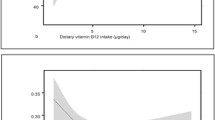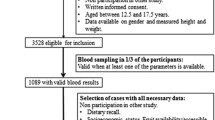Abstract
Purpose
To examine the associations between the dietary intakes of certain B-vitamins from different food sources with the relevant plasma status indices in children.
Methods
A representative subsample of 600 children aged 9–13 years from the Healthy Growth Study was selected. Dietary intakes of vitamins B2, B12, B6 and folate derived from different food sources were estimated. Plasma levels of vitamin B2 (or riboflavin), methylmalonic acid (MMA) and total homocysteine (tHcy) were also measured.
Results
Plasma concentrations of vitamin B2 below 3 μg/L were found in 22.8 % of the children. Children in the lower quartile of dietary vitamin B2 intake were found to have the lowest plasma vitamin B2 levels compared to children in the upper three quartiles (5.06 ± 7.63 vs. 6.48 ± 7.88, 6.34 ± 7.63 and 6.05 ± 4.94 μg/L respectively; P = 0.003). Regarding vitamin B12 children in the lower quartile of dietary intake had higher mean plasma tHcy levels compared to children in the upper two quartiles, respectively (6.00 ± 1.79 vs. 5.41 ± 1.43 and 5.46 ± 1.64 μmol/L; P = 0.012). Positive linear associations were observed between plasma vitamin B2 levels and dietary vitamin B2 derived from milk and fruits (β = 0.133; P = 0.001 and β = 0.086; P = 0.037). Additionally, nonlinear associations were also observed between plasma vitamin B2 levels and vitamin B2 derived from red meat, as well as between tHcy levels and vitamins B12 and B6 derived from milk; vitamins B12, B6 and folate derived from cereal products and folate derived from fruits.
Conclusion
A considerably high prevalence of poor plasma vitamin B2 status was observed in children. The intake of milk, fruits and cereals was associated with more favorable tHcy levels, while the intake of milk and fruits with more favorable plasma B2 levels. However, these findings need to be further confirmed from controlled dietary intervention studies examining the modulation of biomarkers of B-vitamins.
Similar content being viewed by others
References
Said HM (2011) Intestinal absorption of water-soluble vitamins in health and disease. Biochem J 437(3):357–372
Henriques BJ et al (2010) Emerging roles for riboflavin in functional rescue of mitochondrial beta-oxidation flavoenzymes. Curr Med Chem 17(32):3842–3854
Powers HJ, Corfe BM, Nakano E (2012) Riboflavin in development and cell fate. Subcell Biochem 56:229–245
Ross NS, Hansen TP (1992) Riboflavin deficiency is associated with selective preservation of critical flavoenzyme-dependent metabolic pathways. BioFactors 3(3):185–190
Rivlin RS (1970) Riboflavin metabolism. N Engl J Med 283(9):463–472
Powers HJ (2003) Riboflavin (vitamin B-2) and health. Am J Clin Nutr 77(6):1352–1360
FAO (2001) Human vitamin and mineral requirements. In: Report of a joint FAO/WHO expert consultation Bangkok, Thailand. Food and Nutrition Division, FAO, Rome
Briani C et al (2013) Cobalamin deficiency: clinical picture and radiological findings. Nutrients 5(11):4521–4539
Rosenblatt DS, Whitehead VM (1999) Cobalamin and folate deficiency: acquired and hereditary disorders in children. Semin Hematol 36(1):19–34
Whitehead VM (2006) Acquired and inherited disorders of cobalamin and folate in children. Br J Haematol 134(2):125–136
Fowler B, Leonard JV, Baumgartner MR (2008) Causes of and diagnostic approach to methylmalonic acidurias. J Inherit Metab Dis 31(3):350–360
Monsen AL et al (2003) Cobalamin status and its biochemical markers methylmalonic acid and homocysteine in different age groups from 4 days to 19 years. Clin Chem 49(12):2067–2075
McNulty H et al (2008) Homocysteine, B-vitamins and CVD. Proc Nutr Soc 67(2):232–237
Debreceni B, Debreceni L (2014) The role of homocysteine-lowering B-vitamins in the primary prevention of cardiovascular disease. Cardiovasc Ther 32(3):130–138
De Laet C et al (1999) Plasma homocysteine concentration in a Belgian school-age population. Am J Clin Nutr 69(5):968–972
Delvin EE et al (2000) Influence of methylenetetrahydrofolate reductase genotype, age, vitamin B-12, and folate status on plasma homocysteine in children. Am J Clin Nutr 72(6):1469–1473
Bjorke-Monsen AL, Ueland PM (2011) Cobalamin status in children. J Inherit Metab Dis 34(1):111–119
United States Department of Agriculture, Human Nutrition Information Service, Dietary Guidelines Advisory Committee, United States Agricultural Research Service (2010) Report of the Dietary Guidelines Advisory Committee on the dietary guidelines for Americans, 2010: to the Secretary of Agriculture and the Secretary of Health and Human Services, vol vi. United States Dept. of Agriculture, United States Dept. of Health and Human Services, Washington
Moschonis G et al (2010) Social, economic and demographic correlates of overweight and obesity in primary-school children: preliminary data from the Healthy Growth Study. Public Health Nutr 13(10A):1693–1700
Tanner JM (1955) Growth at adolescence. Blackwell Scientific, Oxford, p 212
Cole TJ et al (2007) Body mass index cut offs to define thinness in children and adolescents: international survey. BMJ 335(7612):194
Cole TJ et al (2000) Establishing a standard definition for child overweight and obesity worldwide: international survey. BMJ 320(7244):1240–1243
Trichopoulou A (2004) Composition tables of foods and Greek dishes. Department of Hygiene and Epidemiology, School of MedicineG, Athens
National Research Council Subcommittee on Criteria for Dietary Evaluation (1986) Nutrient adequacy: assessment using food consumption surveys. National Academies Press, Washington
Schofield WN (1985) Predicting basal metabolic rate, new standards and review of previous work. Hum Nutr Clin Nutr 39(Suppl 1):5–41
Goldberg GR et al (1991) Critical evaluation of energy intake data using fundamental principles of energy physiology: 1. Derivation of cut-off limits to identify under-recording. Eur J Clin Nutr 45(12):569–581
Fauci AS et al (2008) Harrison’s principles of internal medicine, 17th edn. McGraw-Hill Medical, New York
Erdogan E et al (2010) Evaluation of reference intervals for methylmalonic acid in plasma/serum and urine. Clin Chim Acta 411(21–22):1827–1829
Papandreou D et al (2006) Reference range of total serum homocysteine level and dietary indexes in healthy Greek schoolchildren aged 6–15 years. Br J Nutr 96(4):719–724
Rush EC et al (2009) Dietary patterns and vitamin B(12) status of migrant Indian preadolescent girls. Eur J Clin Nutr 63(4):585–587
MacFarlane AJ, Shi Y, Greene-Finestone LS (2014) High-dose compared with low-dose vitamin B-12 supplement use is not associated with higher vitamin B-12 status in children, adolescents, and older adults. J Nutr 144(6):915–920
Hay G et al (2011) Folate and cobalamin status in relation to diet in healthy 2-y-old children. Am J Clin Nutr 93(4):727–735
Enquobahrie DA et al (2012) Serum homocysteine and folate concentrations among a US cohort of adolescents before and after folic acid fortification. Public Health Nutr 15(10):1818–1826
Bates B, Lennox A, Prentice A, Bates C, Swan G (2011) National Diet and Nutrition Survey—headline results from years 1, 2 and 3 (combined) of the Rolling Programme (2008/2009–2010/11). A survey carried out on behalf of the Department of Health and the Food Standards Agency. http://www.dh.gov.uk/en/Publicationsandstatistics/Publications/PublicationsStatistics/DH_128166. Accessed 23 Oct 2015
Oldham H, Roberts LJ, Young M (1945) Results of providing a liberally adequate diet to children in an institution; blood and urinary excretion studies before and after dietary improvement. J Pediatr 27:418–427
Drewnowski A (2011) The contribution of milk and milk products to micronutrient density and affordability of the US diet. J Am Coll Nutr 30(5 Suppl 1):422S–428S
Coudray B (2011) The contribution of dairy products to micronutrient intakes in France. J Am Coll Nutr 30(5 Suppl 1):410S–414S
Dainty JR et al (2007) Quantification of the bioavailability of riboflavin from foods by use of stable-isotope labels and kinetic modeling. Am J Clin Nutr 85(6):1557–1564
USDA (2014) United States Department of Agriculture and National Agricultural Library. Standard Reference Database
Institute of Medicine (US) Standing Committee on the Scientific Evaluation of Dietary Reference Intakes and its Panel on Folate Other B Vitamins and Choline (1998) Dietary reference intakes for thiamin, riboflavin, niacin, vitamin B6, folate, vitamin B12, pantothenic acid, biotin, and choline. National Academies Press, Washington
Manios Y et al (2015) Food group and micronutrient intake adequacy among children, adults and elderly women in Greece. Nutrients 7(3):1841–1858
Lutsey PL et al (2006) Serum homocysteine is related to food intake in adolescents: the Child and Adolescent Trial for Cardiovascular Health. Am J Clin Nutr 83(6):1380–1386
Berstad P et al (2007) Dietary fat and plasma total homocysteine concentrations in 2 adult age groups: the Hordaland Homocysteine Study. Am J Clin Nutr 85(6):1598–1605
Makarewicz-Wujec M, Kozlowska-Wojciechowska M (2011) Nutrient intake and serum level of gamma-glutamyltransferase, MCP-1 and homocysteine in early stages of heart failure. Clin Nutr 30(1):73–78
Tucker KL et al (2000) Plasma vitamin B-12 concentrations relate to intake source in the Framingham Offspring study. Am J Clin Nutr 71(2):514–522
Vogiatzoglou A et al (2009) Dietary sources of vitamin B-12 and their association with plasma vitamin B-12 concentrations in the general population: the Hordaland Homocysteine Study. Am J Clin Nutr 89(4):1078–1087
Jacques PF et al (2002) The relationship between riboflavin and plasma total homocysteine in the Framingham Offspring cohort is influenced by folate status and the C677T transition in the methylenetetrahydrofolate reductase gene. J Nutr 132(2):283–288
Green R (2011) Indicators for assessing folate and vitamin B-12 status and for monitoring the efficacy of intervention strategies. Am J Clin Nutr 94(2):666S–672S
Klee GG (2000) Cobalamin and folate evaluation: measurement of methylmalonic acid and homocysteine vs vitamin B(12) and folate. Clin Chem 46(8 Pt 2):1277–1283
Acknowledgments
The biochemical analyses of vitamin B2, MMA and tHcy levels were supported by a research grant from FrieslandCampina. The authors are indebted to the research team members of the Healthy Growth Study, as well as to the parents and children for their willingness to participate in the study.
Funding
The biochemical analyses of vitamin B2, MMA and tHcy levels were supported by a research grant from FrieslandCampina. FrieslandCampina was not involved in the recruitment of participants, data collection, management and analysis, as well as in the final set of results of the current study.
Author contributions
YM and EvdH contributed to the study design. YM, GM, CM and EG were responsible for data collection, management and statistical analyses. All authors contributed to the writing and revising of the manuscript.
Author information
Authors and Affiliations
Corresponding author
Ethics declarations
Conflict of interest
EvdH and RD are employees at FrieslandCampina. None of the other authors have any potential conflict of interest. Any opinions, findings, conclusions or recommendations expressed in the current study are those of the authors and do not necessarily reflect the views of FrieslandCampina.
Electronic supplementary material
Below is the link to the electronic supplementary material.
Rights and permissions
About this article
Cite this article
Manios, Y., Moschonis, G., Dekkers, R. et al. Vitamin B2, vitamin B12 and total homocysteine status in children and their associations with dietary intake of B-vitamins from different food groups: the Healthy Growth Study. Eur J Nutr 56, 321–331 (2017). https://doi.org/10.1007/s00394-015-1082-z
Received:
Accepted:
Published:
Issue Date:
DOI: https://doi.org/10.1007/s00394-015-1082-z




